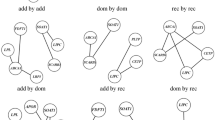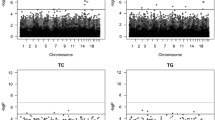Abstract
Apolipoproteins (apo) A-I and C-III are components of high-density lipoprotein-cholesterol (HDL-C), a quantitative trait negatively correlated with risk of cardiovascular disease (CVD). We analyzed the contribution of individual and pairwise combinations of single nucleotide polymorphisms (SNPs) in the APOA1/APOC3 genes to HDL-C variability to evaluate (1) consistency of published single-SNP studies with our single-SNP analyses; (2) consistency of single-SNP and two-SNP phenotype–genotype relationships across race-, gender-, and geographical location-dependent contexts; and (3) the contribution of single SNPs and pairs of SNPs to variability beyond that explained by plasma apo A-I concentration. We analyzed 45 SNPs in 3,831 young African–American (N=1,858) and European–American (N=1,973) females and males ascertained by the Coronary Artery Risk Development in Young Adults (CARDIA) study. We found three SNPs that significantly impact HDL-C variability in both the literature and the CARDIA sample. Single-SNP analyses identified only one of five significant HDL-C SNP genotype relationships in the CARDIA study that was consistent across all race-, gender-, and geographical location-dependent contexts. The other four were consistent across geographical locations for a particular race–gender context. The portion of total phenotypic variance explained by single-SNP genotypes and genotypes defined by pairs of SNPs was less than 3%, an amount that is miniscule compared to the contribution explained by variability in plasma apo A-I concentration. Our findings illustrate the impact of context-dependence on SNP selection for prediction of CVD risk factor variability.



Similar content being viewed by others
References
National Heart, Lung, and Blood Institute (2002) Third report of the National Cholesterol Education Program (NCEP) expert panel on detection, evaluation and treatment of high blood cholesterol in adults (adult treatment panel III). National Institutes of Health, Bethesda, MD. Circulation 106(25):3143–3421
Asztalos BF, HDL Atherosclerosis Treatment Study (2004) High-density lipoprotein metabolism and progression of atherosclerosis: insights from the HDL Atherosclerosis Treatment Study. Curr Opin Cardiol 19:385–391
Tall AR, Small DM (1978) Plasma high-density lipoproteins. N Engl J Med 299:1232–1236
Lund-Katz S, Liu L, Thuahnai ST, Phillips MC (2003) High density lipoprotein structure. Front Biosci 8:d1044–d1054
Wang CS, McConathy WJ, Kloer HU, Alaupovic P (1985) Modulation of lipoprotein lipase activity by apolipoproteins. Effect of apolipoprotein C-III. J Clin Invest 75:384–390
Xu S, Laccotripe M, Huang X, Rigotti A, Zannis VI, Krieger M (1997) Apolipoproteins of HDL can directly mediate binding to the scavenger receptor SR-BI, an HDL receptor that mediates selective lipid uptake. J Lipid Res 38:1289–1298
Groenendijk M, Cantor RM, de Bruin TW, Dallinga-Thie GM (2001) The apoAI-CIII-AIV-AV gene cluster. Atherosclerosis 157:1–11
Sing CF, Boerwinkle E (1987) Genetic architecture of inter-individual variability in apolipoprotein, lipoprotein and lipid phenotypes. In: Bock G, Collins GM (eds) Molecular approaches to human polygenic disease (Ciba Foundation Symposia 130). Wiley, Chichester, pp 99–127
Miller M, Zhan M (2004) Genetic determinants of low high-density lipoprotein cholesterol. Curr Opin Cardiol 19:380–384
Pallaud C, Gueguen R, Sass C, Grow M, Cheng S, Siest G, Visvikis S (2001) Genetic influences on lipid metabolism trait variability within the Stanislas Cohort. J Lipid Res 42:1879–1890
Kamboh MI, Bunker CH, Aston CE, Nestlerode CS, McAllister AE, Ukoli FA (1999) Genetic association of five apolipoprotein polymorphisms with serum lipoprotein-lipid levels in African blacks. Genet Epidemiol 16:205–222
Larson IA, Ordovas JM, Barnard JR, Hoffmann MM, Feussner G, Lamon-Fava S, Schaefer EJ (2002) Effects of apolipoprotein A-I genetic variations on plasma apolipoprotein, serum lipoprotein and glucose levels. Clin Genet 61:176–184
Waterworth DM, Talmud PJ, Bujac SR, Fisher RM, Miller GJ, Humphries SE (2000) Contribution of apolipoprotein C-III gene variants to determination of triglyceride levels and interaction with smoking in middle-aged men. Arterioscler Thromb Vasc Biol 20:2663–2669
Pembrey M (2004) Genetic epidemiology: some special considerations of birth cohorts. Paediatr Perinat Epidemiol 18:3–7
Friedman GD, Cutter GR, Donahue RP, Hughes GH, Hulley SB, Jacobs DR Jr, Liu K, Savage PJ (1988) CARDIA: study design, recruitment, and some characteristics of the examined subjects. J Clin Epidemiol 41:1105–1116
Warnick GR (1986) Enzymatic methods for quantification of lipoprotein lipids. Methods Enzymol 129:101–123
Albers JJ, Adolphson JL (1988) Comparison of commercial kits for apoprotein A-I and apoprotein B with standardized apoprotein A-I and B radioimmunoassays performed at the Northwest Lipid Research Center. J Lipid Res 29:102–108
Fullerton SM, Buchanon AV, Sonpar VA, Taylor SL, Smith JD, Carlson CS, Salomaa V, Stengård JH, Boerwinkle E, Clark AG, Nickerson DA, Weiss KM (2004) The effects of scale: variation in the APOA1/C3/A4/A5 gene cluster. Hum Genet 115:36–56
Efron B, Tibshirani R (2002) Empirical bayes methods and false discovery rates for microarrays. Genet Epidemiol 23:70–86
Nelson MR, Kardia SL, Ferrell RE, Sing CF (2001) A combinatorial partitioning method to identify multilocus genotypic partitions that predict quantitative trait variation. Genome Res 11:458–470
Rohlf FJ, Sokal RR (1994) Biometry. W.H. Freeman, New York
Hamon SC, Stengård JH, Clark AG, Salomaa V, Boerwinkle E, Sing CF (2004) Evidence for non-additive influence of single nucleotide polymorphisms within the apolipoprotein E gene. Ann Hum Genet 68:521–535
Searle SR (1971) Linear models. Wiley, New York
Weir BS (1996) Genetic data analysis 2: methods for discrete population genetic data. Sinauer, Massachusetts
Kamboh MI, Aston CE, Nestlerode CM, McAllister AE, Hamman RF (1996) Haplotype analysis of two APOA1/MspI polymorphisms in relation to plasma levels of apo A-I and HDL-cholesterol. Atherosclerosis 127:255–262
Shioji K, Mannami T, Kokubo Y, Goto Y, Nonogi H, Iwai N (2004) An association analysis between ApoA1 polymorphisms and the high-density lipoprotein (HDL) cholesterol level and myocardial infarction (MI) in Japanese. J Hum Genet 49:433–439
Peacock RE, Temple A, Gudnason V, Rosseneu M, Humphries SE (1997) Variation at the lipoprotein lipase and apolipoprotein AI-CIII gene loci are associated with fasting lipid and lipoprotein traits in a population sample from Iceland: interaction between genotype, gender, and smoking status. Genet Epidemiol 14:265–282
Dallongeville J, Meirhaeghe A, Cottel D, Fruchart JC, Amouyel P, Helbecque N (2000) Gender related association between genetic variations of APOC-III gene and lipid and lipoprotein variables in northern France. Atherosclerosis 150:149–157
Miller M, Rhyne J, Khatta M, Parekh H, Zeller K (2001) Prevalence of the APOC3 promoter polymorphisms T-455C and C-482T in Asian–Indians. Am J Cardiol 87:220–221
Hartl DL, Clark AG (1997) Principles of population genetics, 3rd edn. Sinauer, Massachusetts
Davey Smith G, Egger M (1998) Meta-analysis. Unresolved issues and future developments. BMJ 316:221–225
Benjamini Y, Hochberg Y (1995) Controlling the false discovery rate: a practical and powerful approach to multiple testing. J R Stat Soc 57:289–300
Churchill GA, Doerge RW (1994) Empirical threshold values for quantitative trait mapping. Genetics 138:963–971
Lynch M, Walsh B (1998) Genetics and analysis of quantitative traits. Sinauer Associates, Massachusetts
Hamon SC, Kardia SLR, Boerwinkle E, Liu K, Klos KLE, Clark AG, Sing CF (2006) Replicate evidence for intragenic and intergenic interactions between SNP effects in the APOA1/C3/A4/A5 gene cluster. Hum Hered 61:87–96
Spence MA, Greenberg DA, Hodge SE, Vieland VJ (2003) The emperor’s new methods. Am J Hum Genet 72:1084–1087
Brem RB, Kruglyak L (2005) The landscape of genetic complexity across 5,700 gene expression traits in yeast. Proc Natl Acad Sci U S A 102:1572–1577
American Heart Association (2005) Heart disease and stroke statistics—2005 update. American Heart Association, Dallas, TX
Barrett-Connor E (1997) Sex differences in coronary heart disease. Why are women so superior? The 1995 Ancel Keys Lecture. Circulation 95:252–264
Cooper R, Cutler J, Desvigne-Nickens P, Fortmann SP, Friedman L, Havlik R, Hogelin G, Marler J, McGovern P, Morosco G, Mosca L, Pearson T, Stamler J, Stryer D, Thom T (2000) Trends and disparities in coronary heart disease, stroke, and other cardiovascular diseases in the United States: findings of the national conference on cardiovascular disease prevention. Circulation 102:3137–3147
Greenlund KJ, Kiefe CI, Gidding SS, Lewis CE, Srinivasan SR, Williams OD, Berenson GS (1998) Differences in cardiovascular disease risk factors in black and white young adults: comparisons among five communities of the CARDIA and the Bogalusa heart studies. Coronary artery risk development in young adults. Ann Epidemiol 8:22–30
Kiefe CI, Williams OD, Bild DE, Lewis CE, Hilner JE, Oberman A (1997) Regional disparities in the incidence of elevated blood pressure among young adults: the CARDIA study. Circulation 96:1082–1088
Schoenborn CA, Adams PF, Barnes PM, Vickerie JL, Schiller JS (2004) Health behaviors of adults: United States, 1999–2001. National Center for Health Statistics. Vital Health Stat 10(219)
Helgason A, Yngvadottir B, Hrafnkelsson B, Gulcher J, Stefansson K (2005) An Icelandic example of the impact of population structure on association studies. Nat Genet 37:90–95
Jorgenson E, Tang H, Gadde M, Province M, Leppert M, Kardia S, Schork N, Cooper R, Rao DC, Boerwinkle E, Risch N (2005) Ethnicity and human genetic linkage maps. Am J Hum Genet 76:276–290
Reiner AP, Ziv E, Lind DL, Nievergelt CM, Schork NJ, Cummings SR, Phong A, Burchard EG, Harris TB, Psaty BM, Kwok PY (2005) Population structure, admixture, and aging-related phenotypes in African–American adults: the cardiovascular health study. Am J Hum Genet 76:463–477
Risch N, Burchard E, Ziv E, Tang H (2002) Categorization of humans in biomedical research: genes, race and disease. Genome Biol 3:1–12
Sawyer SL, Mukherjee N, Pakstis AJ, Feuk L, Kidd JR, Brookes AJ, Kidd KK (2005) Linkage disequilibrium patterns vary substantially among populations. Eur J Hum Genet 13:677–686
Hirschhorn JN, Lohmueller K, Byrne E, Hirschhorn K (2002) A comprehensive review of genetic association studies. Genet Med 4:45–61
Sing CF, Stengård JH, Kardia SL (2003) Genes, environment and cardiovascular disease. Arterioscler Thromb Vasc Biol 23:1190–1196
Acknowledgements
This work was supported by NIH grants HL072810, HL072905, HL039107, GM065509, HC095095, HC048047, HC048048, HC048049, HC048050, HC045134, and HC05187. The authors would like to thank Lynn Illeck, Paul Kopec, Deborah Theodore, and Kenneth G. Weiss for their technical support and research assistance.
Author information
Authors and Affiliations
Corresponding author
Additional information
CHRISTINE M. BROWN received her B.S. in Zoological Anthropology from the University of Michigan, Ann Arbor, MI, and is currently working towards her Masters degree in Epidemiology in the School of Public Health. She is presently a Research Associate in the Dept. of Human Genetics at the University of Michigan, Ann Arbor, MI.
CHARLES F. SING received his Ph.D. in Statistics and Genetics from North Carolina State University in Raleigh, NC. He is currently a Professor in the Dept. of Human Genetics at the University of Michigan, Ann Arbor, MI.
Electronic supplementary material
Below is the link to the electronic supplementary material.
Rights and permissions
About this article
Cite this article
Brown, C.M., Rea, T.J., Hamon, S.C. et al. The contribution of individual and pairwise combinations of SNPs in the APOA1 and APOC3 genes to interindividual HDL-C variability. J Mol Med 84, 561–572 (2006). https://doi.org/10.1007/s00109-005-0037-x
Received:
Accepted:
Published:
Issue Date:
DOI: https://doi.org/10.1007/s00109-005-0037-x




